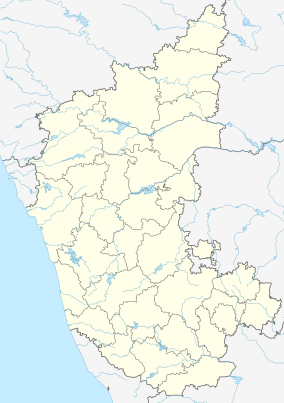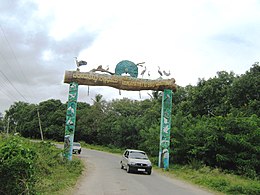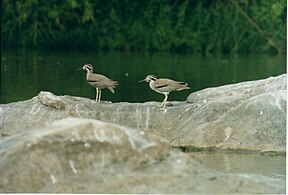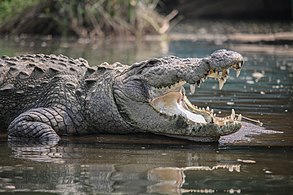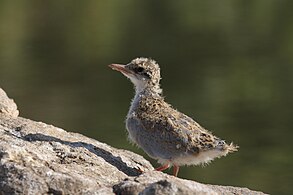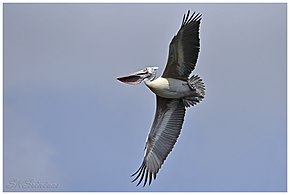Ranganathittu Bird Sanctuary
| Ranganathittu Bird Sanctuary | |
|---|---|
IUCN category IV (habitat/species management area) | |
 Spot-billed pelican taking off | |
Location in Map of Karnataka | |
| Location | Mandya, Karnataka, India |
| Coordinates | 12°24′N 76°39′E / 12.400°N 76.650°E |
| Area | 40 acres (16 ha) |
| Established | 1940 |
| Visitors | 304,000 (in 2016–17) |
| Governing body | Ministry of Environment and Forests, Government of India |
| Official name | Ranganathittu Bird Sanctuary |
| Designated | 15 February 2022 |
| Reference no. | 2473[1] |
Ranganathittu Bird Sanctuary (also known as Pakshi Kashi of Karnataka),[2] is a bird sanctuary in the Mandya District of Karnataka in India. It is the largest bird sanctuary in the state,[3] 40 acres (16 ha) in area,[4] and comprises six islets on the banks of the Kaveri river.[5] The sanctuary has been designated on 15 February 2022 as a protected Ramsar site since 2022.[1]
Ranganathittu is located 3 km (1.9 mi) from the historic town of Srirangapattana and 16 km (9.9 mi) north of Mysore.[6] The sanctuary attracted about 3 lakh visitors during 2016–17.[7]
History

Ranganathittu's islets were formed when an embankment across the Kaveri river was built between 1645 and 1648 by the then king of Mysore, Kanteerava Narasimharaja Wadiyar.[8] These islets, originally numbering 25, soon started attracting birds. The ornithologist Salim Ali observed that the islets formed an important nesting ground for a large variety of birds, and persuaded the king of Mysore to declare the area a protected area in 1940.[6] The sanctuary is currently maintained by the Forest Department of Karnataka and efforts are ongoing to improve the sanctuary, including purchasing nearby private land to expand the protected area.[4] In 2014, around 28 square km around the sanctuary was declared as an eco-sensitive zone, meaning that certain commercial activities cannot take place without the government's permission.[9]
Flooding
The sanctuary with its islets experience heavy flooding during certain rainy seasons when water is released from Krishna Raja Sagara dam upstream, due to heavy rains. During heavy flooding boating is suspended and tourists are allowed to watch the nesting birds from a distance.[8] Frequent flooding has also damaged some portions of three islands over past few decades.[10]
Biome
Most of the park is within a riparian area.
Flora

Riverine reed beds cover the banks of the islands, while the islands themselves are covered in broadleaf forests, with dominant species being Terminalia arjuna (Arjun tree), bamboo groves, and Pandanus trees. Eucalyptus and acacia trees have also been planted, which might lead to long-term eradication of native species. The endemic and threatened lily Iphigenia mysorensis of the family Colchicaceae also grows in the sanctuary.
Fauna
Birds

Roughly 170 bird species[11] have been recorded. Of these, the painted stork, Asian openbill stork, common spoonbill, woolly-necked stork, black-headed ibis, lesser whistling duck, Indian shag, stork-billed kingfisher, egret, cormorant, Oriental darter, spot-billed pelican and heron breed at Ranganathittu regularly. The great stone plover, and river tern also nest there, while the park is also home to a large flock of streak-throated swallows.[6] Ranganathittu is a popular nesting site and about 8,000 nestlings were sighted during June 2011.[12] About 50 pelicans have made Ranganathittu their permanent home.[10]
During winter months, starting from mid-December, as many as 40,000 birds congregate at Ranganathittu, some migrating from Siberia, Latin America and parts of north India.[13] During January and February, more than 30 species of migratory birds can be found in the sanctuary.[14]
Mammals and reptiles
The islands are host to numerous small mammals including bonnet macaque, smooth coated otter, colonies of flying fox and common small mammals such as common palm civet and Indian gray mongoose. Additionally, there is a population of monitor lizards. The mugger crocodile or marsh crocodile is a common inhabitant of the riverine reed beds and Ranganathittu has largest fresh water crocodile population in Karnataka state.[15]
Activities

Ranger-guided boat tours of the isles are available throughout the day, and are a good way to watch birds, crocodiles, otters, and bats. There is no lodging within the sanctuary, so visitors typically stay over at Mysuru or Srirangapatna. The seasons for visiting the park are June–November (during the nesting season of the water birds). The best time to watch migratory birds is usually December but it can vary year to year.
The Salim Ali Interpretation Centre, maintained by Forest Department, screens a 4- minute documentary to special interest groups.[10]
Accessibility
- Nearest Town: Srirangapatna (3 km)
- Nearest City: Mysuru (19 km)
- Nearest Railhead: Srirangapatna
- Nearest Airport: Mysore Airport (25 km)
- Nearest Highway: Bangalore – Mysuru highway (2 km)
Gallery
- Road entrance to the sanctuary
- Indian Grey Hornbill feeding on fig.
- Meal partners, painted storks aiding each other
- Painted Stork taking flight
- Painted stork searching for food
- Snowy egret pair
- Pair of great stone-curlews
- Troop of white ibises
- Crocodile basking
- Cattle egret in breeding plumage
- River Terns mating
- River Tern chick
- Spot-billed pelican taking flight
- Spot-billed pelican in flight
- Flying foxes
References
- ^ a b "Ranganathittu Bird Sanctuary". Ramsar Sites Information Service. Retrieved 7 August 2022.
- ^ "From Here and There". Deccan Herald. Retrieved 23 November 2010.
- ^ "Karnataka News : Rs. 1 crore sanctioned for developing Bonal Bird Sanctuary near Surpur". The Hindu. 8 January 2011. Archived from the original on 16 October 2013. Retrieved 5 December 2012.
- ^ a b Shiva Kumar, M T (9 June 2012). "Creating more space for the birds". The Hindu. Retrieved 19 February 2013.
- ^ "Ranganathittu Bird Sanctuary".
- ^ a b c "Ranganathittu Bird Sanctuary". The Hindu. Chennai, India. 25 September 2006. Archived from the original on 23 January 2011. Retrieved 23 November 2010.
- ^ Shivakumar, M. K. (24 April 2017). "Ranganathittu draws over 24 lakh tourists since 2008-09". The Hindu. Retrieved 26 April 2017.
- ^ a b "Heavy rainfall causes flooding in Ranganathittu bird sanctuary". The Hindu. 25 October 2005. Archived from the original on 11 April 2013. Retrieved 19 February 2013.
- ^ Arasu, Sibi (3 August 2019). "Ranganathittu bird sanctuary braces for the monsoon". The Hindu. ISSN 0971-751X. Retrieved 15 August 2019.
- ^ a b c R, Krishna Kumar (4 May 2009). "Ranganathittu gets a new look". The Hindu. Archived from the original on 26 April 2013. Retrieved 19 February 2013.
- ^ "Bird Checklist – Mysore Nature". www.mysorenature.org. Retrieved 5 January 2018.
- ^ DHNS (10 June 2011). "8,000 nestlings sighted at Ranganathittu". Deccan Herald. Retrieved 19 February 2013.
- ^ M.T., Shiva Kumar (28 January 2013). "Ranganathittu comes alive with winged beauties". The Hindu. Retrieved 19 February 2013.
- ^ "Ranganathittu reports record revenue". The Hindu. 9 January 2012. Retrieved 19 February 2013.
- ^ TNN. "Sanctuary crocs fear extinction". The Times of India mobile edition. Archived from the original on 12 April 2013. Retrieved 19 February 2013.

